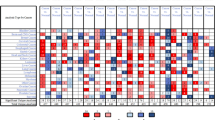Summary
The aim of the present study was to explore the differentially expressed genes in the blood vessel endothelial cells (BVECs) between diffuse large B-cell lymphoma (DLBCL) and reactive lymph node hyperplasia (RLNH), and to perform an initial bioinformatics analysis on a novel gene, C20orf14, which is highly expressed in lymph node of lymphoma. The mRNA of the tissue from the BVECs of DLBCL and RLNH tissues was labeled with biotin respectively and hybridized with expression profile microarray, and the differentially expressed genes were obtained. Initial bioinformatics analysis was performed on a novel gene named C20orf14. Its gene structure, genomic localization, the physical and chemical characteristics of the putative protein, subcellular localization, functional domain etc. were predicted, and the systematic evolution analysis was performed on the similar proteins among several species. By using expression profile microarray, many differentially expressed genes were uncovered. The efficient bioinformatics analysis have fundamentally identified that C20orf14 was a nuclear protein, and may be involved in the post-transcription modification of mRNA. Therefore, microarray is an efficient and high throughout strategy for the detection of differentially expressed genes, and C20orf14 is thought to be a potential target for tumor metastasis researches by bioinformatics analysis.
Similar content being viewed by others
References
Alizadeh A A, Eisen M B, Davis R E et al. Distinct types of diffuse large B-cell lymphoma identified by gene expression profiling. Nature, 2000,403(6769): 503–511
Colomo L, Lopez-Guillermo A, Perales M et al. Clinical impact of the differentiation profile assessed by immunophenotyping in patients with diffuse large B-cell lymphoma. Blood, 2003,101(1):78–84
Hida K, Hida Y, Amin D N et al. Tumor-associated endothelial cells with cytogenetic abnormalities. Cancer Res, 2004,64:8249–8255
Streubel B, Chott A, Huber D et al. Lymphoma-specific genetic aberrations in microvascular endothelial cells in B-cell lymphomas. N Engl J Med, 2004,351:250–259
St Croix B, Rago C, Velculescu V et al. Genes expressed in human tumor endothelium. Science, 2000,289:1197–1202
Buckanovich R J, Sasaroli D, O’brien-Jenkins A et al. Use of immuno-LCM to identify the in situ expression profile of cellular constituents of the tumor microenvironment. Cancer Biol Ther, 2006,5(6):635–642
Spiess A N, Mueller N, Ivell R. Amplified RNA degradation in T7-amplification methods results in biased microarray hybridizations. BMC Genomics, 2003,4:44
Dumur C I, Garrett C T, Archer K J et al. Evaluation of a linear amplification method for small samples used on high-density oligonucleotide microarray analysis. Anal Biochem, 2004,331(2):314–321
Zhang Z, Schwartz S, Wagner L et al. A greedy algorithm for aligning DNA sequences. J Comput Biol, 2000,7(1–2):203–214
Apweiler R, Attwood T K, Bairoch A et al. The InterPro database, an integrated documentation resource for protein families, domains and functional sites. Nucleic Acids Res, 2001,29(1):37–40
Bendtsen J D, Nielsen H, von Heijne G et al. Improved prediction of signal peptides: SignalP 3.0. J Mol Biol, 2004,340(4):783–795
Puntervoll P, Linding R, Gemund C et al. ELM server: A new resource for investigating short functional sites in modular eukaryotic proteins. Nucleic Acids Res, 2003, 31(13):3625–3630
Zhu T, Wu M F, Zhou J H et al. Bioinformatic analysis of SFT2D1—a highly expressed gene in hepatic metastasis of ovarian cancer. BioMegnetism (Chinese), 2005,5(4):1–5
Yang M X, Qu X, Han K J et al. Application of bioinformatics in analysis of human gene HCA 56. Basic Clin Med (Chinese), 2005,25(2):169–172
Groves M R, Barford D. Topological characteristics of helical repeat proteins. Curr Opin Struct Biol, 1999,9:383–389
D’Andrea L D, Regan L. TPR proteins: the versatile helix. Trends Biochem Sci, 2003,28(12):655–662
Smith D F. Tetratricopeptide repeat cochaperones in steroid receptor complexes. Cell Stress Chaperones, 2004,9(2):109–121
Streubel B, Chott A, Huber D et al. Lymphoma-specific genetic aberrations in microvascular endothelial cells in B-Cell lymphomas. New Eng J Med, 2004,351:250–259
Hida K, Hida Y, Amin D et al. Tumor-associated endothelial cells with cytogenetic abnormalities. Cancer Res, 2004,64:8249–8255
Author information
Authors and Affiliations
Corresponding author
Additional information
Liangping SU, male, born in 1964, Doctorial Candidate
This project was supported by grants from National “973” Key Basic Research and Development Program Foundation (No. 2002CB513100) and the transversal project of Tongji Hospital, Tongji Medical College, Huazhong University of Science and Technology (No. 2007004) of China.
Rights and permissions
About this article
Cite this article
Su, L., Chen, D., Zhang, J. et al. The expression and bioinformatic analysis of a novel gene C20orf14 associated with lymphoma. J. Huazhong Univ. Sci. Technol. [Med. Sci.] 28, 97–101 (2008). https://doi.org/10.1007/s11596-008-0125-6
Received:
Issue Date:
DOI: https://doi.org/10.1007/s11596-008-0125-6




